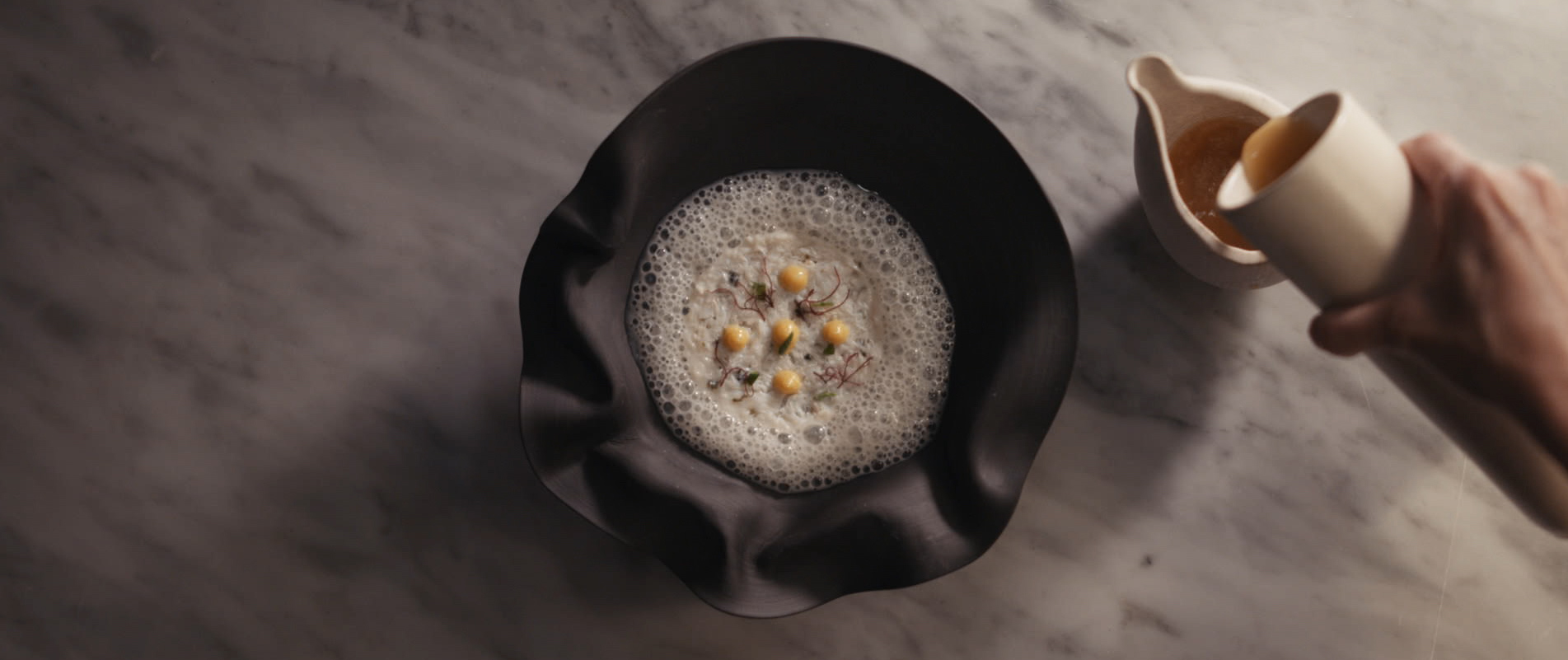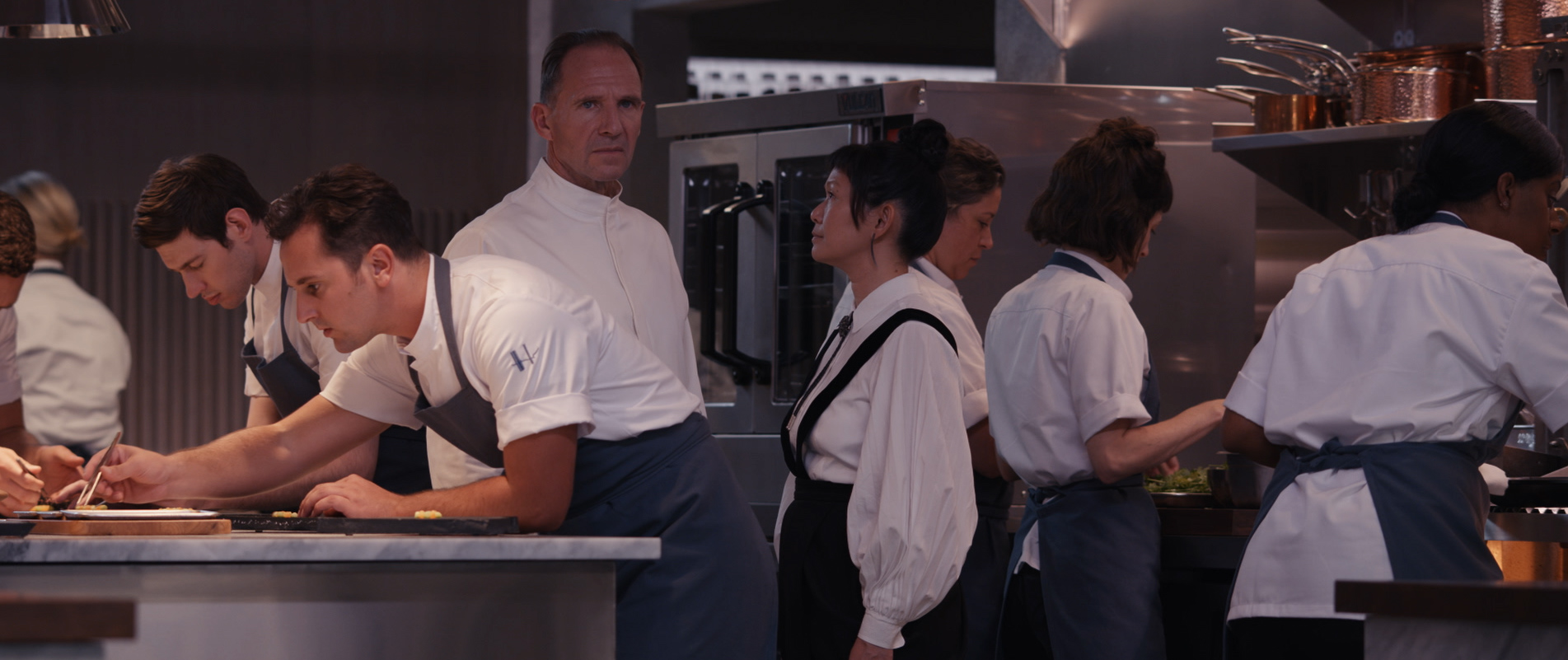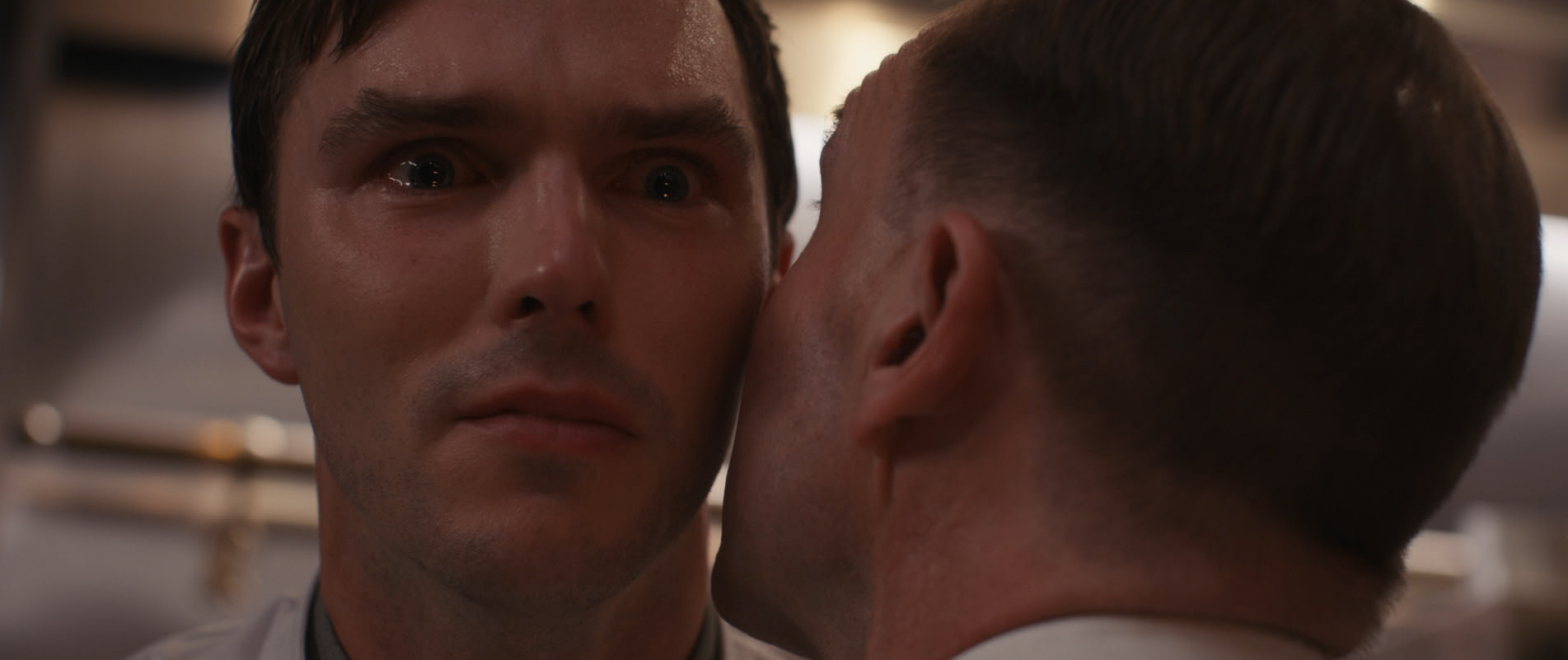[Disclaimer: This article necessarily includes spoilers for ‘The Menu.’ Consider yourself warned; please do not bitch to me about them.]
The central premise of The Menu is that it takes place amid the ultimate foodie’s wet dream: an exclusive, one-service-per-night tasting menu presented by an acclaimed chef at a restaurant on a private island. It’s also a movie that’s never stingy on detail, one of its strengths. In the opening scene, über-foodie Tyler, played by Nicholas Hoult, spars with his date, Margot, played by Anya Taylor-Joy, about the adventure they’re about to embark upon.
“12 customers a night? How do they turn a profit?” she asks.
“$1,250 a head, that’s how,” Tyler says.
“You’re kidding, right? What are we, eating a Rolex?”
Tyler, clearly, is the true believer and Margot the skeptic — a fairly traditional dramatic setup. Not only is The Menu heavy on detail, most of those details also ring true, or true enough, to anyone familiar with the world of food media, “haute cusine,” etc.
Part of which is a credit to their chief creative consultant, Dominique Crenn, the first female chef in the US to be awarded three Michelin stars and arguably at least as acclaimed as The Menu‘s fictional chef-teur, Julian Slowik, played by Ralph Fiennes. It was reportedly Crenn, who has been known to write the menus in her own restaurants in the form of poems, who conceived most of the dishes in the film, from the alginated “lemon caviar” to the breadless bread plate.
That the film so clearly aspires to that kind of accuracy (and as far as I could tell, largely succeeds) naturally got us wondering: could a restaurant really offer the kind of experience Hawthorn does for $1,250?
For her part, the Margot character clearly believes that’s a ridiculous price for a meal. But as the movie depicts it, the meal does include:
- A ferry ride to a private island.
- An exclusive, one-per-night tasting menu (with seven courses — one of which is a fiery death, but still…).
- Locally harvested seafood (scallops).
- Locally-milled grains (for bread that the diners don’t get to eat).
- Locally dry-aged meats (DAIRY COWS ONLY!)
- Full wine pairings (including a natural one, “with a little barnyard funk to it”).
“Is this a realistic price” was my editor’s prompt, and yet… the seemingly simple question of whether a restaurant could offer what Hawthorn did for the price described is actually a more complex tangle of sub-questions. Such as:
- Could Hawthorn charge $1,250 a head and still turn a profit?
- Could they do that ethically/sustainably?
- Is $1,250 a person an exorbitant price or a bargain?
The first question is complicated further by some artistic choices. At some point, we find out that Chef Slowik has “an angel investor,” who “kept him open through COVID.” This raises the question of whether Hawthorn would even need to turn a profit, or if some rich guy was just keeping it open at some level of loss as an ego thing/tax write-off for his other businesses (talk of him tampering with the menu does seem to suggest that he tried to compromise its integrity to cut costs). Still, any qualms about the level of luxury on offer at that price could simply be hand-waved away with “well, the investor was losing money on it.”
It’s also, we find out, going to be Chef Slowik’s last service (spoiler alert?). Thus, turning a profit presumably wasn’t a huge concern. You probably don’t fill out your costs ledger for at least a few weeks before your giant murder-suicide. Alas, we press on.
PART I — Is $1,250 A Fair Market Price?

For the sake of argument, let’s assume Hawthorn was a profitable restaurant at some point or was designed to be. Now, is $1,250 a realistic price? It seems logical to compare Hawthorn to some of its obvious analogs:
- A tasting menu at Noma will reportedly set you back about $770, including wine pairings.
- For Alain Ducasse at the Dorchester, you’re looking at £210 ($247.80), plus wine pairings at levels of £125 ($147.50), £250 ($295), and £500 ($590). That’s $837.50 for the most expensive version.
- The testing menu at The French Laundry is $390 for food, plus $500 for wine pairings — so $890. They also have a “black truffle and caviar dinner” next month for $1,200, which is pretty close to the $1,250 people are paying at Hawthorn.
None of those prices (which aren’t easy to find, by the way, presumably to keep out the riff-raff) includes an exclusive seating for 12, one service per night, a ferry ride to a private island, or the famous chef knowing your name and deepest personal foibles, as Julian Slowik does. On the question of whether $1,250 is a believable price for Hawthorn, the answer is clearly “yes.”
Slowik is presumably juuust a bit more famous than some of the world famous chefs we know, and Hawthorn’s offerings juuust a touch more fabulous, and thus it costs a hair more than the fanciest single service at The French Laundry. I’m fairly certain the writers conceived it that way.
PART II — Is That Fair Market Actually… Fair?

Whether $1250 a pop for 12 seats is a sustainable price is more complicated. The aforementioned Noma, in Copenhagen, a perennial on any list of the world’s best restaurants, recently announced that it would be closing its doors at the end of 2024 (almost too-perfectly timed to The Menu hitting HBO Max). Noma’s influence on The Menu is fairly obvious to people who have heard of Noma. For anyone else The Menu‘s production designer spelled it out to Variety, back in November:
“Hawthorn’s austere style is clearly influenced by restaurants like Noma, where Tobman once spent a memorable Christmas Eve, hanging out with the staff for 12 hours on the night before it closed for a lengthy break. ‘The staff was rather rowdy that night,’ he remembers. ‘I learned so much about their techniques and I thought if I could ever do a film that captured this environment, it would be the greatest gift.'”
The reason for the announcement — which was actually something of a flex in and of itself, given that most high-end restaurants saying they will be open for the next two years would be a statement of hubris rather than a retirement announcement — according to chef founder Rene Redzepi was that the fine dining model was “unsustainable.”
“Financially and emotionally, as an employer and as a human being, it just doesn’t work,” Redzepi told the Times.
In an essay he wrote in 2015, he also noted, “In an ideal restaurant, employees could work four days a week, feel empowered and safe and creative. The problem is how to pay them enough to afford children, a car, and a house in the suburbs.”
In that sense, a famous restaurant is kind of like a sports dynasty. The more successful it gets, the more entitled the role players feel to be paid a salary commensurate to their successful work, which is tough to do while also paying the superstars exorbitant superstar salaries, commensurate with their being the premiere superstars.
That being said, the line cooks in The Menu don’t have cars, children, or houses in the suburbs. Just a barracks with unpartitioned beds (14 of them, by my count) and communal toilets — sort of a knowing parody of the phenomenon I just described in the above graf. Obviously, The Menu‘s version is a bit of heightened reality but it’s not terribly far off from the workplace described in this piece about Blaine Wetzel (whose restaurant was also on a private island).
Even acknowledging that it’s hard to ask “could that be a sustainable business model?” without asking the corollary “should that be a sustainable business model?” As The Noma example seems to suggest, public sentiment about the latter is beginning to affect the former. Famous chefs know they can’t expect their sous to sleep in barracks anymore. Perhaps that’s part of why this dinner is Chef Slowik’s last hurrah. Also, Noma, elBulli, and other restaurants operating at the caliber of Hawthorn rely on “stages” to work for free in exchange for being able to say “I cooked at Noma!” Though I will note — it’s tough to imagine a short-term free laborer still being committed enough to kill themselves in order to help the chef’s execute his vision.
Chef John Benhase from Savannah, Georgia, where The Menu was shot, helped run a chef boot camp for the actors playing Slowik’s chefs, taking time off from his work as a real chef. I put the question of whether Hawthorn could be a sustainable business to him directly and he immediately brought up the matter of stages.
“I think we’re seeing more and more that the model of stage labor [basically the chef version of an unpaid internship] and semi-free labor and stuff like that is no longer something that’s sustainable or realistic at all,” Benhase told me. “Whether it ever really was is a whole other question. So that would be my question to your question: who knows how many of those people were working there just because of the place, and whether they were even getting paid, or if the payment was just room and board and proximity to greatness.”
That an aspiring chef would take on upwards of six figures of debt in culinary school only to get their foot in the door of an industry that relies on chefs working for free and minimum-wage doesn’t make much sense, and wouldn’t seem to bode well for the long-term prospects of a system that relied on it. As Buddha Lo, the most recent Top Chef winner told me after his victory, “I’ve always found it a bit weird with the schooling system and the culinary schools in the US. For me to be a chef, I went to culinary school in Australia, where they realized that they have a skill shortage in cooks,” he explained.
“So they decided instead of people having to pay to go to school, everyone gets paid to go to school. So I got all these incentives to be a cook. I think that’s what’s affecting our cooking industry in the US is that nobody’s going to go to pay thousands of dollars for cooking college and then get paid $13 an hour at a good restaurant.”
Suffice it to say, the question of whether Hawthorn could function at the listed price seems to be yes, and the question of whether Hawthorn should function at the listed price could fill a thesis or a policy paper. That the model itself seems untenable is one of the themes of the movie. Asking a cook to kill himself for his head chef is just the low-wage/high-regard fine dining system taken to its logical if semi-absurd endpoint. That’s The Menu in a nutshell.
The inherent paradox of fine dining is that it takes what can be the most selfless act of service — feeding someone — and turns it into both high art and luxury commerce, both of which prize exclusivity. Which is to say, the opposite of selfless service. That’s not a critique of fine dining (which I, and most chefs I spoke to for this piece, enjoy), and in fact, The Menu seems to work best on people near enough to acknowledge that paradox.
PART III — Is $1,250 As Ridiculous As It First Sounds?

“Believe it or not, I didn’t charge you enough.”
This brings us to question number three: is $1,250 for that meal exorbitant or a bargain?
“Could I see myself paying that?” John Benhases says. “Absolutely, if I could afford it. But I think that I’m a poor representation of that. I’ve been spending all of my money on going out to eat and drink since I didn’t have any money.”
A lot of chefs were conditional in similar ways. Chef William Preisch of Abbey Road Farm in Oregon — himself a chef prone to making foams and “snow” and ice cream from the lees at the bottom of a wine barrel — initially said, “if that were Thomas Keller or David Kinch and [Hawthorn] was what they did instead of The French Laundry or Manresa, my answer would probably be ‘yes.'”
As our conversation evolved, he walked that back. “I mean truthfully, I won’t pay $1250 for anyone’s food. That price point that doesn’t compute for me.”
Food, at its basic level, is sustenance. Which shouldn’t be exclusive. But at its higher end, it’s art, it’s an experience, it’s an “event.” Would I, personally, rather find a different exceptional meal for less money than the one in Hawthorn? Sure. But would I rather spend $1,250 on the Hawthorn experience (assuming it didn’t result in my death) than, say, floor tickets to an NBA game or some such? I’d probably go Hawthorn.
At the risk of being crushingly obvious, whether $1,250 is a ridiculous price to pay for Hawthorn kind of depends on whether you’re a Tyler or more of a Margot. Which is to say, a rich foodie who would do a murder-suicide for the perfect meal, or a seen-it-all sex worker who just wants to give handjobs and crush cheeseburgers. Jk, but what I mean is, do you just want to eat or do you want to see art and have an experience? The beauty of The Menu as a movie, to me, is that does a pretty good job of juggling both. It’s a tasting menu that inspires reflection but doesn’t leave you feeling like you still need a cheeseburger afterwards.
I asked Chef Benhase if we’re spoiled in terms of how much we’ve become accustomed to paying for restaurant food.
“100%,” Benhase agreed. “I think people are wanting to get paid more and they should, given cost of living, given all the different parts of our society and economy right now. But then people are assuming that food is going to stay the same price. But if you don’t factor in labor and things like that into the price of the final product, then it’s not a sustainable business.”
—
Vince Mancini is on Twitter. You can read more of his reviews here.







